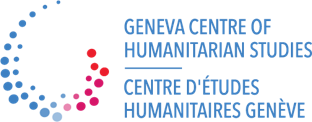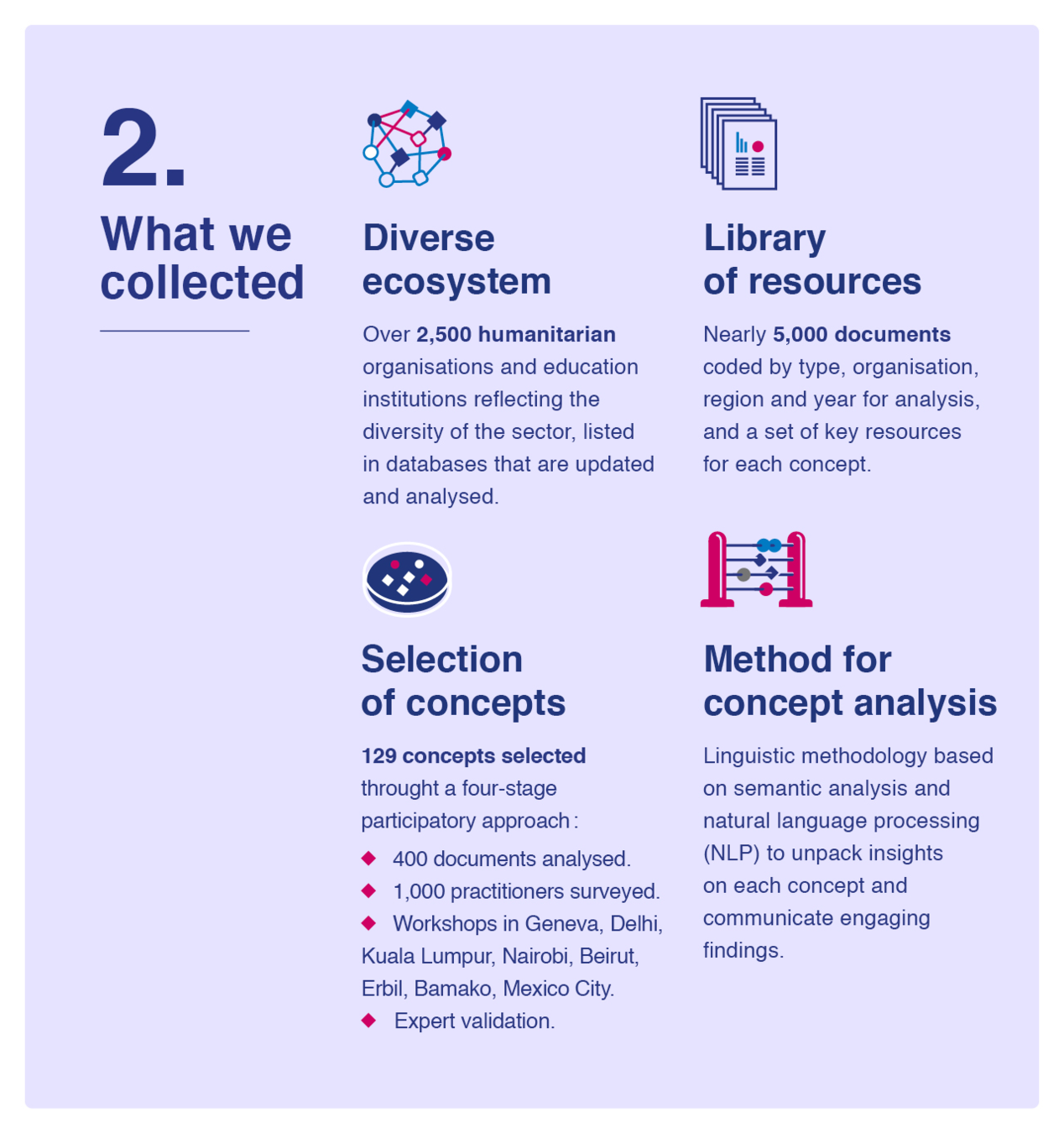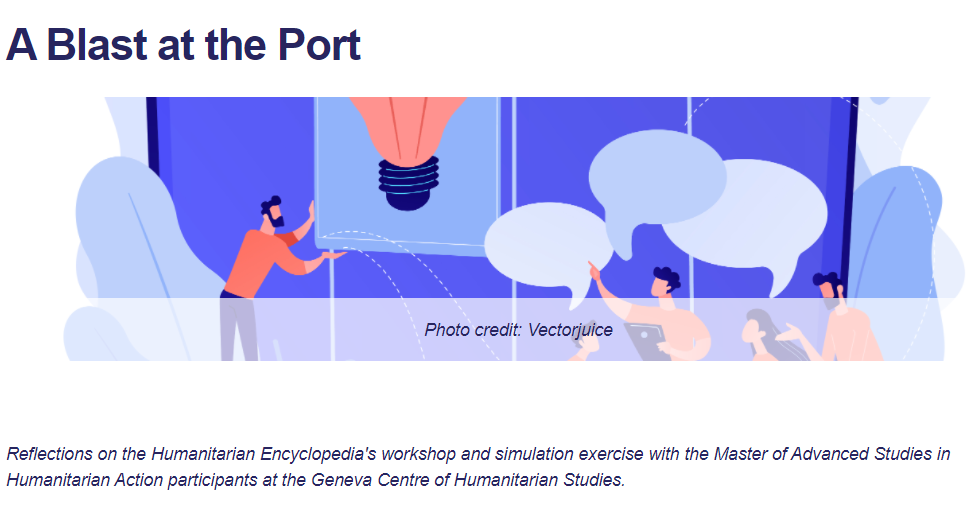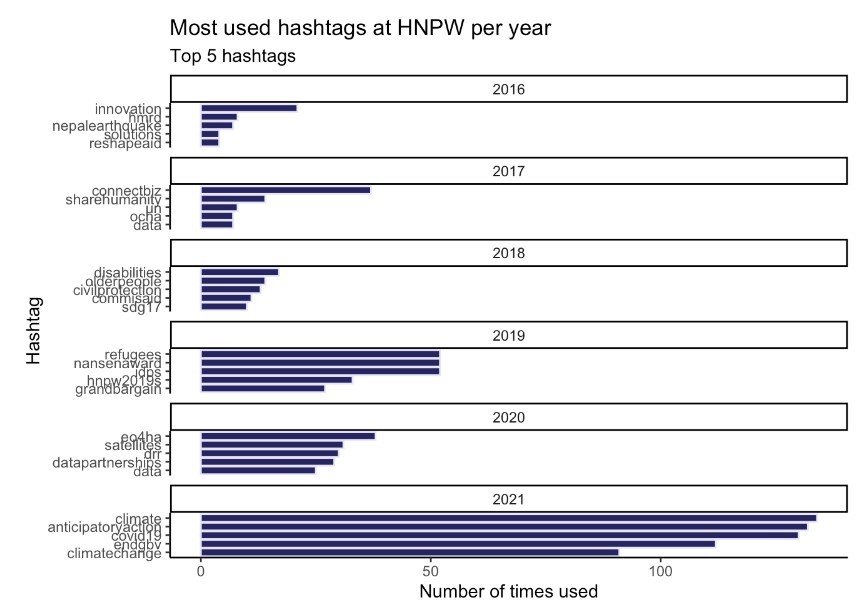



The Humanitarian
Encyclopedia
October 2021
Research methods, process and findings

The Humanitarian Encyclopedia project in a poster













Humanitarians desire a shared understanding of key concepts
For humanitarians, a shared understanding of concepts:
- Is crucial for coordination
- Helps build trust
- Resolves disagreements
- Improves performance
- Facilitates measurement
- Guides decision-making
- Needs ongoing updating
- Is a goal of trainings and workshops
But, it remains to be achieved
Is crucial for coordination
We have more than 2,000 staff working in over 50 country, regional and headquarters locations. Our staff come from almost 100 countries, bringing local knowledge and commitment to humanitarian response efforts... In any crisis , making sure that everyone has a shared understanding of the problem and what needs to be done is crucial .

| 2012,AR-4084,Activity_Report,North_America,UN_OPA,IGO |
Helps build trust
Trust was clearly seen as lacking throughout the region, which could be due to lack of communication and lack of shared understanding, particularly of the 'spoken language' of the humanitarian world.

| 2015,GD-4,General_Document,Asia,0,WHS |
Resolves disagreements
Achieving genuine integration requires a clear, shared understanding of what it actually means in practice. There are still fierce disagreements within the UN over whether integration constitutes an 'enabling framework' for planning and prioritisation, a mechanism to promote coordination or the de facto 'merging' of administrative and operational polices and programmes.

| 2007,GD-44,General_Document,Europe,0,C/B |
Improves performance
In particular, there is a proliferation of agencies claiming to do protection but no shared understanding of what it involves, with under-qualified staff and poorly thought-through strategies and insufficient attention to how it affects other aspects of humanitarian action.

| 2010,GD-16,General_Document,Europe,Net_GP,Net |
Facilitates measurement
The concept of resilience has a long history and has received expansive treatment in fields such as engineering, psychology, economics, social and natural sciences. Its application in the development and humanitarian fields is a relatively recent phenomenon... One implication is that the concept in development and humanitarian circles remains rather variably defined. Because of this... measurement can be complex...

| 2016,GD-103,General_Document,Europe,IFRC,RC |
Guides decision making
As we look ahead to 2025 and beyond, there are at least three things that should be done to enable a more resilient future. First, it is important that development and humanitarian actors, at all levels, develop a shared understanding of resilience that can guide decision-making.

| 2016,GD-103,General_Document,Europe,IFRC,RC |
Is a goal of trainings and workshops
The concepts of gender, diversity and power and the connection between poverty and gender inequality were explored... The training developed a shared understanding of how to incorporate the concepts into organisational practices.

2013,AR-1245,Activity_Report,Oceania,NGO_Fed_IA,NGO_Fed
Needs ongoing updating
This report contains the updated and endorsed terminology related to disaster risk reduction... The agreement on terminology also helps countries and organizations to build shared understanding and foster coherent policy across the disaster risk reduction, sustainable development and climate change agendas...

| 2018,GD-127,General_Document,Europe,UN_OPA,IGO |
Remains to be achieved
While admirable efforts have been made to align some of the main quality and accountability initiatives in the sector (such as the Sphere Project, Humanitarian Accountability Partnership International, People in Aid and the Emergency Capacity Building Project), the humanitarian sector is far from reaching a shared understanding about what quality and accountability mean.

| 2011,GD-100,General_Document,Europe,IFRC,RC |

Humanitarians co-exist in a diverse ecosystem
#HODataStories show a diverse sector of 2,500+ organisations
5,000 documents show how they communicate
Participatory selection of 129 key humanitarian concepts

- 400 documents analysed
- 1,080 practitioners surveyed
- Workshops in 8 locations
- Expert validation
A comprehensive sample of domain specific discourse
Some concepts suggest a shared understanding may be possible
Others show diverse and divergent perspectives on meaning and practice
Even definitions of fundamental principles like humanity are contested
And what "protection" involves in practice is far from clear

Humanitarian communication is characterised by diversity
Humanitarian communication
takes different forms
- Humanitarians communicate with:
- other humanitarians
- decision-makers
- donors
- the general public
- affected people
- scholars & students
- etc.

Conceptual variation, fuzziness, diversity
affects many domains
- E.g. in science, conceptualisations of HYPOTHESIS vary across disciplines (Donovan et al., 2015)
- E.g. in education, the term GENE varies in textbook discourse across countries (Gericke et al., 2012)
-
In the humanitarian domain, studies have found divergent understandings of:
- RESILIENCE (Bené et al., 2012)
- HUMANITARIAN SPACE
(Collision & Elhawary, 2012) - CRISIS (Darcy & Hofmann, 2003)

Humanitarian documents contain many examples of conceptual diversity
- Protracted Crisis
- Psychosocial Support
- Grand Bargain
- Leave No One Behind
- Humanitarianism
- Humanitarian-Development Peace Nexus (Triple Nexus)
- Gender-Based Violence
- Neutrality

Nuanced context specific definitions are lacking
The IASC should propose, for consultation and agreement with UN Member States, humanitarian organizations that are not part of the IASC, and development partners, definitions of protracted crises (nuanced according to context) and clear operational criteria for systematic and predictable transition from humanitarian action to that of a developmental and/or peace-building nature.
Protracted Crisis
General_Document, Asia, WHS, 2015, GD-4
No OCHA definition
OCHA has no formal definition of large, long-term crises.
General_Document, North_America, IGO, UN_OPA, 2019,
GD-143
Defining for funding purposes
Consideration needed to be given to how defining (sic) 'psychosocial support' in order to ensure its inclusion in funding proposals.
Psychosocial Support
General_Document, Europe, RC, IFRC, 2016, GD-103
Varies among and within aid organisations, disciplines and culture
Also, there is some confusion in the field about definitions of key terms of psychosocial support or resilience that vary between and within aid organizations, disciplines and cultures (Patel et al., 2011).
General_Document, Europe, RC, IFRC, 2016, GD-103
No common understanding
There is currently no consistent or common understanding of what changes the Grand Bargain aims to bring about, or what actions are necessary to deliver them.
Grand Bargain
General_Document, Europe, Net, Net_GP, 2018, GD-138
As the number of signatories has increased, so differences in expectations, interpretations and understanding of both specific commitments and the Grand Bargain's overall goals have grown, as evidenced in the significant inconsistencies in information presented in the self-reports, and the differing opinions expressed during interviews for this report.
No commonly agreed definition
Leave No One Behind
General_Document, Europe, IGO, IGO_Other, 2016, GD-156
The concept of leaving no one behind needs to be clarified to guide programming and projects and to develop the right instruments.
Because there is no common definition for leave no one behind, the categories of focus are often broad (gender, women and girls; people with disabilities; children; youth).
Most people have an instinctual understanding of what it means to leave no one behind, but there is no commonly agreed definition.
Leave no one behind must also be thought of in terms of not leaving future generations behind – it is, in other words, a dynamic concept.
General_Document, Europe, IGO, IGO_Other, 2016, GD-156
Universal or a Western construct?
Some believe the current notions of humanitarianism are primarily Western and Northern in origin, and hypocritical when it comes to upholding the humanitarian principles.
Humanitarianism
General_Document, Asia, WHS, 2015, GD-4
Humanitarianism through the UN-led system is increasingly perceived in the global South as a Western construct consisting of a set of values and interests that are not universally shared in the places where it intervenes. Some non-Western states worry that humanitarian action can be used as an excuse to violate sovereignty.
General_Document, Europe, Net, Net_GP, 2015, GD-15
Conceptions of humanitarianism vary across cultures and contexts, and the Western established model is increasingly challenged and contested as a universal model.
General_Document, Europe, RC, IFRC, 2015, GD-99
A lack of clarity and understanding of conceptual discussions and implications
Aware that many in our community lacked clarity and understanding on the conceptual discussions behind the triple nexus and the implications at practical level, the annual conference and the webinar series provided opportunities for further discussions with actors from across the nexus.
Humanitarian-Development-Peace
Nexus (Triple Nexus)
Activity_Report, Europe, Net, Net_NGO_Trans, 2018, AR-2429
Traditional vs expansive understandings
For many humanitarian agencies and practitioners, gender-based violence remains synonymous with violence against women and girls. This paradigm is, however, shifting. There are now calls for GBV prevention and response in humanitarian settings to focus on a wider range of gendered and sexualised violence, such as sexual violence directed at men in conflict, and violence against gay, lesbian, transgendered and intersex people. Some child protection actors argue that forced recruitment of boys into fighting forces is a form of gender-based violence.
Gender-Based Violence
General Document, Europe, C/B, 2014, GD-67
Debating the inclusion of men and boys
The idea that men and boys can simply be added to policies, documents and frameworks that aim to address violence against women is simplistic and problematic. It does not help build knowledge or understanding of the causes and consequences of sexualised and gendered violence against men and boys in conflict and disaster-affected settings, nor does it contribute to the development of good practice in responding to violence, which requires evidence-based and theory-driven frameworks.
Gender-Based Violence
General Document, Europe, C/B, 2014, GD-67
Western and other Understandings?
MSF's concept of neutrality was perceived differently in the Yemeni context. National staff suggested that it would be difficult for the community to conceive of an organisation without political motivations, partly because of linguistic and conceptual differences in understandings of 'neutrality'. Given the highly politicised nature of Arab society, political neutrality is generally not understood in the same way that Western humanitarian organisations articulate the concept. For example, neutrality was not possible in the Iraq war or the Israeli–Palestinian conflict, and individuals were generally assumed to have a political stance on most issues. Political neutrality in Yemen was thus more localised, and focused on MSF's neutrality in tribal conflicts. In Yemen, emphasising 'religious neutrality', plurality and openness to all religions was seen to be more important than references to political neutrality.
Neutrality
General_Document, Europe, C/B, 0, 2009, GD-52

How can we help humanitarians navigate this diversity?
A Descriptive Approach
Our three-fold approach describes diverse meanings to help humanitarians understand them, without prescribing the single definition of a concept

~3~
Forum:
fostering discussions and debates among humanitarians.
~1~
Corpus linguistics:
describing conceptual dynamics through textual analysis.
~2~
Expertise notes:
eliciting conceptual reflections and analysis by experts.
Textual analysis and corpus linguistics can help:
(Vestegaard, 2021: 113)
- Address the lack of cumulation of humanitarian knowledge.
- Harmonise fragmented conceptualisations.
- Connect empirical and theoretical knowledge.
- Quantitatively corroborate qualitative analysis.
- Provide an encompassing conceptual description.
- Complement expert knowledge.
- Combine authors, organisations, document types, etc.
- Overcome biases of traditional introspective review methods.
- Unveil theoretically unconsidered relations between concepts.
(Allen, 2017)
What does this linguistic analysis look like?
- Presents and compares definitions from humanitarian documents.
- Proposes an encompassing definition by aggregating elements of other definitions.
- Pinpoints controversies and areas of conceptual fuzziness.
- Uncovers differences in conceptualisation across organisations and regions.
- Is guided by domain experts and issues raised by practitioners

Linguistic analysis report ("LAR")
Developing the LAR
We have iterated the method from traditional static reports to interactive reports with lexical data visualisation
- More engaging for expert authors
- Easier to communicate and interpret
- Practitioner relevant findings can be shared immediately


Linguistic-Expert Knowledge
Exchange Process
- Expert Priming and Expertise Baseline
- Linguistic Analysis & Refinement
- Conceptual Description & Entry Building

A process that involves:
- humanitarian experts/generalists
- linguistic analysts
- Three phases:
Linguistic-Expert Knowledge
Exchange Process
Phase 1: Expert Priming & Expertise Baseline
A linguist's analysis is primed by:
- briefing from humanitarian researcher/practitioner
- expertise notes
- expert presentation
- suggested readings
- specific research questions from experts



Linguistic-Expert Knowledge
Exchange Process
Phase 2: Linguist Analysis & Refinement
- linguist provides expert/generalist with LAR
- expert provides feedback, comments, suggestions
- linguist clarifies findings
- expert may request further analysis on specific questions, debates, controversies.


Linguistic-Expert Knowledge
Exchange Process
Phase 3: Conceptual Description & Entry Building
Expert/generalist:
- consults LAR and captures findings
- combines findings with research and domain expertise
- writes a concept entry in the Humanitarian Encyclopedia

Visualising Lexical Data about Humanitarian Concepts
Representing Definitional Elements for Impartiality
Representing Conceptual Development for
Accountability to Affected Populations (AAP)
Debates and Controversies about Participation
Overview of a concept
Each LAR contains:
- Frequencies of use by organisation type, region, document type and year
- Definitions and elements of a definition
- Related concepts
- Nearby terms (co-locations) that qualify the usage of a concept
- Synonyms and antonyms of the concept
- Trends and usage over time
- Debates and controversies
Extract definitions
An epidemic (...) is the occurrence of disease cases in a population or region that clearly is in excess of normal expectancy
(General document, Europe, C/B, 2005, GD-38)
Collate definitional elements
Epidemic...
is a type of {emergency, crisis, disaster, threat, disease, shock...}
affects {people, regions, countries, animals...}
can be triggered or spread by {organisms, environmental conditions, population movements...}
can cause {deaths, suffering, fear, stigma, impact...}
can be managed by actions such as prevention; forecasting; preparedness; detection; response
Explore practitioner insights
Absolute and relative occurrences of "crisis"
Identify issues, debates & controversies
The need to compromise on humanitarian principles to conduct effective negotiations is repeated by several authors. This is more or less couched as a sacrifice meant for the greater good: it is an organisation's dilemma whether no access is better than compromised access. Still, this observation is contradicted in other cases, where it is thought that strict adherence to principles is the best path forward.
Example linguistic insights from a LAR on "negotiation"

How well does the method work?
The Definition Game
4 conceptual descriptions
1 written by an HE linguist analyst

- Accountability
- Participation
- Crisis
- Epidemic
Expert or Linguist?
In humanitarian settings, the notion of accountability can have different interpretations. Generally, it is used to describe functioning and transparent relations between people and institutions involved in a humanitarian action, including governments, international and national organizations, civil society organizations, and private companies. The term underlines the responsible use of power in an unbalanced setting where humanitarian actors have significant power over populations affected by crisis and emergency. In such contexts, accountability is seen as a key element through which affected populations can fully benefit from humanitarian response and relief operations.
Accountability
Expert or Linguist?
In humanitarian discourse, participation is a form of active engagement and a key factor in empowering communities. It is regarded as a time-consuming process that promotes behavioural change. Participation refers to the involvement of either affected populations or all stakeholders in humanitarian response, especially in areas of decision-making. Having originated in the field of development, the notion is conceptualised as a spectrum with minimal and full participation on each end. Participation is believed to create a sense of ownership in aid recipients who participate in humanitarian programmes. For this reason, it is linked to programme sustainability, and said to be increased when humanitarians carry out specific activities (engaging with local actors, training locals, involving locals in specific programme areas like need identification, promoting bottom-up institutional building, implementing monitoring and feedback mechanisms, etc.).
Participation
Expert or Linguist?
A humanitarian crisis is framed as “an event or series of events that represents a critical threat to the health, safety, security or wellbeing of a community or other large group of people, usually over a wide area” (Humanitarian Coalition). Humanitarian crises can be the result of different causes such as natural catastrophes (an earthquake, a cyclone, a flood, a drought, etc.); human-driven actions (armed conflict, fire, etc.) or a combination of the two (famine, displacement). Such classifications, however, are contestable, as natural events are not merely the result of natural processes. The effects of and responses to natural disasters are related to social inequalities and wider political and economic processes.
Crisis
Expert or Linguist?
In the humanitarian world, livelihoods are activities that allow people to secure the basic necessities of life, such as food, water, shelter and clothing. The term has historically drawn special attention as it is widely employed by non-governmental organizations (NGOs) and United Nations agencies dealing with development and relief in rural and urban environments. The frequently protracted nature of crises produced by human-made conflict or natural disasters has ended up placing greater emphasis on refugee capacity to develop coping mechanisms and self-reliance, which have now gained great momentum in international debates.
Livelihoods
Which one was NOT written by an expert?

Participation
was solely based
on a LAR

The other conceptual descriptions were obtained from De Lauri, 2020

How do we ensure the Humanitarian Encyclopedia is useful for practitioners?
Why do you want to...

Since I am not a practitioner but would be interested in becoming one, I find it useful to have information on all different actors and what they do. -- Humanitarian practitioner
It's important to connect different humanitarian practitioners, academics, students to one another but also to ensure the knowledge is shared and available/accessible to a wider population. It's an opportunity to discuss and engage with one another to positively grow the field. -- Humanitarian teacher
28%
Why do you want to...
As a researcher, it would be helpful to have a resource repository to turn to on some of the most common concepts in the field. -- Humanitarian researcher
Because I am currently conducting PhD research on NGO accountability from the perspective of NGO practitioner -- Humanitarian practitioner
As a practitioner and current student in the field, reaching sources and materials would shape my understanding of humanitarian action and enrich my professional experience. -- Humanitarian pracitioner

28%
Why do you want to...
Because I want to be aware about other perspectives before taking the next step, and to exchange experiences. -- Humanitarian practitioner
As student I can consider the discuss part the place where I can contribute the most. --
Humanitarian student
It's important to connect different humanitarian practitioners, academics, students to one another... It's an opportunity to discuss and engage with one another to positively grow the field. -- Humanitarian teacher

44%
User first impresssions


Lessons learned on the content
- Describe divergence, but don't standardise
- Highlight key facts and findings
- Engage the crowd and embrace their diversity
- Keep products easy to access and refer to
- Acknowledge limitations, but layer messages and details
- Remain focused on the humanitarian domain; avoid drift
- Complement, connect and distinguish from other reference works
- Ensure resources and services meet humanitarians' needs

Strategic areas moving forward
- A strong community of practice on line and around the world
- Grow users and engage with partners
- "Concepts & Community"
- Disseminate packages and services
- Accessible, interactive, dynamic content
- MOOC, Forum, Webinars, Workshops, Games, Scenarios
- Concepts-in-a-minute
- Interactive content and visualisations
- Identify trends and analysis
- Track emerging concepts and trends
- Identify skills and needs

Some prototypes -->
Spread the word

- Newsletter
- News features
- Tweets
- Pamphlets
- Outreach
- Workshops
- Author calls
- Forum polls
Complex concepts in a minute?
Complex concepts in a minute?
Workshops, games, scenarios and more

Including other languages


Analysing and predicting trends


What else can we learn about the humanitarian sector, discourse and narratives?
The top 10 concepts appear frequently in multiple collections
| Concept | Corpus Total | Syllabi Total | Syllabi Rank |
|---|---|---|---|
| development | 236453 | 517 | 5 |
| child | 179513 | 133 | 32 |
| health | 178378 | 964 | 3 |
| community | 176662 | 274 | 21 |
| need | 117251 | 422 | 6 |
| management | 98678 | 294 | 10 |
| security | 91704 | 1006 | 1 |
| education | 90685 | 49 | 54 |
| policy | 89658 | 297 | 9 |
| aid | 89047 | 654 | 4 |
Some org. types refer to the 129 concepts more/less than others


Concepts of interest do change


Exploring the effect of events on discourse with Twitter data




The Humanitarian
Encyclopedia
20 October 2021
Analysing shifts in humanitarian discourse with Twitter data
What's happening in humanitarian discourse?
- The Humanitarian Encyclopedia has 129 concepts selected in 2019
- We analyse these concepts in documents from 2005-2019 (71 million word corpus)
- Are they still relevant?
- What new concepts, jargon, buzz words are emerging?
- Why?
HNPW: A key humanitarian event

An online opportunity for analysis

Hashtags reflect important events

So who is driving this discourse?

And where are they based?

Corpus and Twitter are significantly correlated

The data needs some work for analsyis (1)

The data needs some work for analsyis (2)

But there are some very rough effects to be found (1)

1 occurrence in Corpus -> 0.025*** increase on Twitter (AME)
But there are some very rough effects to be found (2)

1 occurrence on Twitter -> 7.99*** increase on Twitter (AME)
What do we know so far?
- Events like HNPW are a potential barometer of the key concepts in the HNPW discourse.
- Our corpus is ageing, but it is still significantly related to Twitter data about HNPW
- Both reinforce our ability to observe the nature and evolution of discourse.
- And validate the relevance of the Humanitarian Encyclopedia linguistic method.
Why does this matter?
-
Is the discourse actually changing? Static? Going round in circles?
-
Who or what really drives humanitarian the discourse?
-
Who or what should drive the humanitarian discourse?
- How can we ensure local voices and perspectives are heard at the global level?
Next steps?
-
Identify more trigger events:
-
Conflict events (ACLED)
-
Natural disaster events (EMDAT)
-
Policy events (Geneva International)
-
-
Triangulate observations of discourse:
-
Humanitarian Encyclopedia document collection
-
Humanitarian Twitter lists
-
Latest reports and updates (Reliefweb)
-
Other sources?
-
A possible model?





Determinants of conceptual evolution in humanitarian discourse
03 November 2021
Empirical analysis of the use of key humanitarian concepts over time
IHSA World Conference on Humanitarian Studies, Paris



Participatory selection of 129 key humanitarian concepts

- 400 documents analysed
- 1,080 practitioners surveyed
- Workshops in 8 locations
- Expert validation
A comprehensive sample of domain specific discourse
impartiality
humanity
neutrality
independence
humanitarian-development nexus
localisation
leave no one behind
do no harm
crimes
testimony
sanitation
water
displacement
migration
impartiality
humanity
neutrality
independence
humanitarian-development nexus
localisation
leave no one behind
do no harm
crimes
testimony
sanitation
water
displacement
migration










Localisation
Terrorism
What determines these changes over time?
- Historical/disciplinary influences over time
- Geographic/cultural contexts
- Organisation types
- Interaction of these factors
- Natural variation of the language
- Something else?
4,828 documents show baseline trends in humanitarian discourse
| Nexus Dialogue on Environment, Peace and Security | Peace, Security and Disarmament | 24/01/2019 | Maison de la paix | https://unemg.org/environment-peace-and-security-nexus-dialogue/ |

HQAI @_HQAI· Apr 27 Now at #hnpw: panel on #localisation & #accountability. @IqbalUddin says local actors are there forever. Applying international standards such as the #CoreHumanitarianStandard is crucial to ensure the sustainability of #humanitarian activities and to be accountable to people.

Ebola vaccination began today in the Democratic Republic of the Congo’s North Kivu Province where a case was confirmed on 8 October. People at high risk [cf. vulnerable, non-resilient, etc.], including contacts of the confirmed case and first responders will receive the doses as the health authorities move to curb the spread of the virus. (WHO, 13 Oct 2021)

Token extraction
People at high risk, including contacts of the confirmed case and first responders will receive the doses as the health authorities move to curb the spread of the virus. (WHO, 13 Oct 2021)
Fuzzy matching
algorithm
to count occurrences
for 129 concepts
risk = 1
response = 1
health = 1
authorities = 1
epidemic = 0
Year = 2021
Organisation type = IGO
Region = Europe
# local/
recipient
occurrences
# global/
donor
occurrences
If localisation is happening,
local concepts will be more prominent in contemporary discourse
(if not, global will be)
# events
# disasters
# twitter

Global
->
Events

Global
->
Disasters
Global
->
Tweets

What we might
expect to find?
An increase in the occurrence of a concept in humanitarian documents from global organisation types 2005-2018 predicts a positive increase in the occurrence of the concepts in Geneva Event Titles, Reliefweb Disaster Descriptions, and HNPW Twitter events.
Some exploratory results
- Significant correlations between variables in the main corpus and new data from Geneva events, HNPW Tweets, Reliefweb disasters.
- Significant effects for a basic linear model for the effect of global/local/donor/recipient determinants on new data sets.
- Magnitude of effects is bigger for global v local; donor v recipient. All significant.
Limitations and next steps
- More sophisticated theory and models of discourse evolution need to be developed.
- Refine the token extraction (some inflation at high end)
- Control variables under construction
- Concept level (e.g. single v multiword, noun v verb)
- Document level (e.g. document properties)
- Event/source level (e.g. disaster characteristics)
- Global/local/donor/recipient categorisations are broad and imperfect.
- Baseline "local" document collection could be enhanced incl. by better accounting for languages.
- Other new data sources?


humanitarianencyclopedia.org